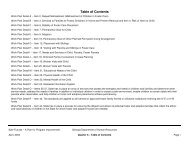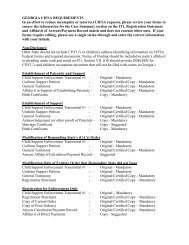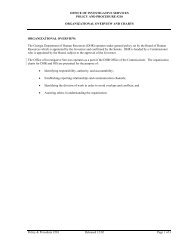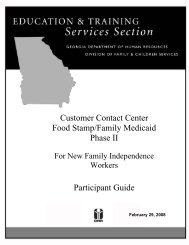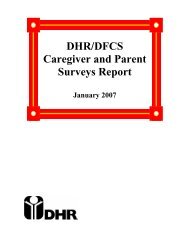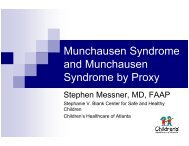an overview georgia program improvement plan - Department of ...
an overview georgia program improvement plan - Department of ...
an overview georgia program improvement plan - Department of ...
Create successful ePaper yourself
Turn your PDF publications into a flip-book with our unique Google optimized e-Paper software.
Neglect was determined to be the most prevalent type <strong>of</strong> subst<strong>an</strong>tiated maltreatment <strong>an</strong>d accounted for 67% <strong>of</strong> the incidents in foster<br />
care. Lack <strong>of</strong> supervision was the most common type <strong>of</strong> neglect <strong>an</strong>d accounted for 74% <strong>of</strong> subst<strong>an</strong>tiated neglect cases. Emotional <strong>an</strong>d<br />
physical abuse each accounted for 12% <strong>of</strong> the subst<strong>an</strong>tiated incidents. Sexual abuse followed <strong>an</strong>d accounted for 6% <strong>of</strong> the total<br />
incidents with other abuse, described as exposure to drugs, comprising the remaining 3%.<br />
A comparison <strong>of</strong> the foster care victims to non-victim foster care children produced very similar pr<strong>of</strong>iles. The me<strong>an</strong> age <strong>of</strong> the foster<br />
care victim was 8.5 years compared to 8.6 years in the non-foster care victim. The foster care victim is most likely female, (58%),<br />
compared to 51% female in non-victim foster children. The ethnicity <strong>of</strong> the foster care victim is reportedly Black, (72%). While nonvictim<br />
foster children are reportedly 54% Black. Georgia’s largest counties accounted for 52% <strong>of</strong> foster care victims <strong>an</strong>d 46% <strong>of</strong> nonfoster<br />
care victims.<br />
Foster families involved in maltreatment investigations are 52% single parent <strong>an</strong>d 48% two-parent families. The me<strong>an</strong> age <strong>of</strong> the<br />
single foster parent was 51 years <strong>an</strong>d the majority <strong>of</strong> that group (92%) is female. Two-parent foster families have a me<strong>an</strong> age <strong>of</strong> 49<br />
years for both foster mother <strong>an</strong>d father. Sixty-two percent <strong>of</strong> foster mothers <strong>an</strong>d 57% <strong>of</strong> foster fathers are identified as Black. Thirtyeight<br />
percent <strong>of</strong> foster mothers <strong>an</strong>d 36% <strong>of</strong> foster fathers were identified as White. Single parent foster families were more likely to be<br />
associated with neglect investigations th<strong>an</strong> two-parent families. Two-parent families were more likely to be associated with<br />
emotional, physical, <strong>an</strong>d sexual abuse th<strong>an</strong> single-parent families.<br />
See attachments 2-A3, A4, <strong>an</strong>d A6 a <strong>an</strong>d b for further details.<br />
8 th Quarter DOCUMENTATION: Per ACF 7 th quarter request: (1) Pr<strong>of</strong>ile Report on the Maltreatment <strong>of</strong> Children in Foster Care<br />
(Victim Data Pr<strong>of</strong>ile), <strong>an</strong>d (2) Pr<strong>of</strong>ile Summary Report - The Maltreatment <strong>of</strong> Foster Children<br />
BARRIERS TO ACHIEVEMENT:<br />
1 st Quarter Report: Currently the data collection instrument (Form 431) is completed for all assessments <strong>of</strong> abuse or neglect in foster<br />
homes or institutions. The children in the foster homes/institutions are not separated in groups <strong>of</strong> children in agency custody vs.<br />
children in parental custody. In producing the report a mech<strong>an</strong>ism to monitor data collection <strong>of</strong> children included a paper copy <strong>of</strong><br />
investigations to better identify <strong>an</strong>d describe foster care victims. 1 st Quarter Federal Response: (DESCRIBE ACTION YOU WILL<br />
TAKE DURING THE NEXT PIP QUARTER TO MEET THE PROJECTED BENCHMARKS AND/OR GOALS).<br />
3 rd Quarter Georgia Reply: This benchmark was achieved therefore there are no barriers.<br />
Safe Futures – A Pl<strong>an</strong> for Program Improvement<br />
Georgia <strong>Department</strong> <strong>of</strong> Hum<strong>an</strong> Resources<br />
November, 2004 Quarter 8 - Work Pl<strong>an</strong> A Page 5




